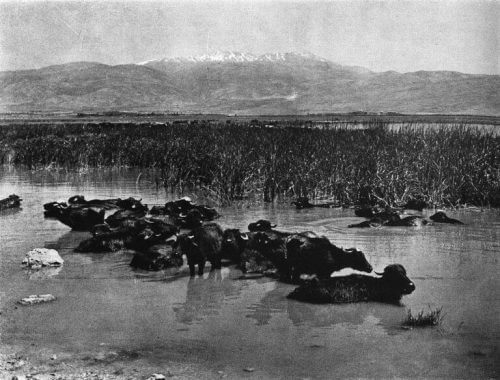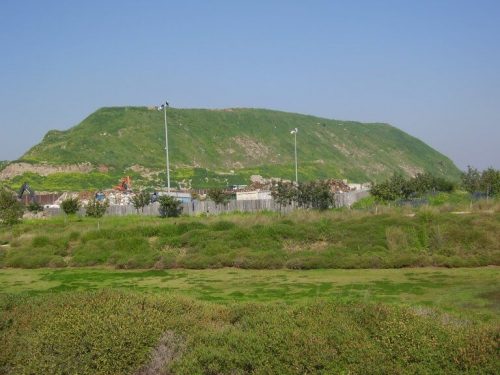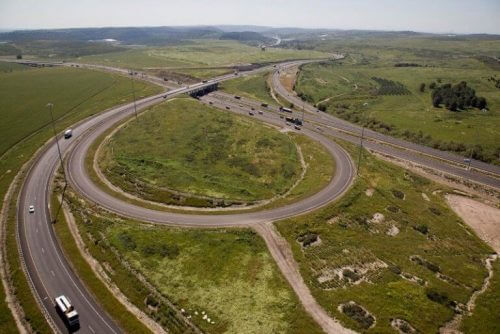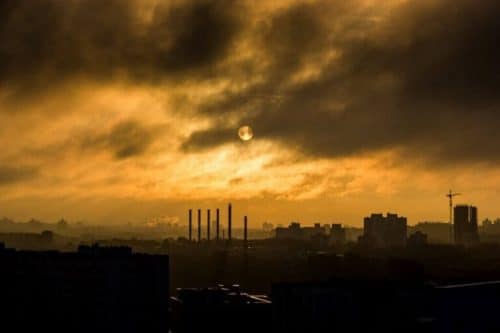From the desiccation of the sick to the desalinated water revolution: the seven influential environmental events in Israel's history - a special project of Eter Zoyt on the occasion of the 70th Independence Day and Earth Day, which occur in close proximity this year

By Racheli Vox and Maya Falah, Angle, Science and Environment News Agency
The first 70 years of the State of Israel were full of developments and changes in the field of the environment, some of which will accompany us in the decades to come. In honor of the 70th Independence Day, we have chosen seven environmental turning points that have shaped our lives here and will continue to influence us in the decades to come:
1. Drying the patient - and rehabilitation
Let's start, of course, with the first environmental struggle in the country's history. In 1951, after decades in which the drying of the swamps was one of the central symbols of the pioneers and of the building of the country, it was decided to dry what seemed to be the biggest swamp of all: the Hula. For seven years, an area of about 62 thousand dunams was drained with extraordinary engineering efforts. However, the plans also aroused opposition, and led to the organization of key naturalists in Israel, who opposed the severe damage to the unique flora and fauna of the region. This first nature struggle led to the establishment of the Society for the Protection of Nature in 1953 (initiated by Prof. Heinrich Mendelsohn, Azaria Alon and Prof. Amots Zahavi) as well as the establishment of Israel's first nature reserve, the Hula Reserve, which was declared in 1964 and included a small part of the lake's surface.
In retrospect, it became clear that drying the patient caused a lot of environmental damage, which far outweighed the benefits of the move. As a result of the drying, animal and plant species that existed until then only in Hula, such as the Galilean Nun, the sandy Tavernon, and the Hula Lebanon fish, were exterminated. The populations of many other species were greatly reduced, and many species of birds stopped nesting in Israel. In addition, the drying meant that many organic substances, which used to sink in the marsh, began to flow into the Sea of Galilee, where they polluted the water and harmed the fish. As a result, in the 90s, a re-flooding project of a small part of the former marshlands began, and the Hula Reed was established, where you can now walk and watch birds. The restoration process contributes to the return of some of the migratory birds to the area, and attempts are being made to get bird species to come back and nest in the area.
Drying the patient is an example of the enormous damages that can be caused when humans interfere with nature, and shows how much such measures require a great deal of thought, an accurate assessment of the situation and the expected results of human actions and a thorough calculation of the benefits against the possible damages.
2. "Go to the landscape but don't pick" - the fight to save the wildflowers

"And you were as beautiful as a flower that shouldn't be picked", sings Omer Adam, but until the mid-60s people didn't see picking flowers as wrong. In those days, people took wildflowers as common property, something that existed in infinite quantities, and it was very common to return from nature walks with many beautiful flowers that had been picked. This phenomenon caused many flowers to face the danger of extinction, and naturalists realized that if it continued many of them would disappear.
In 1963, the National Parks and Nature Reserves Law was enacted, which, among other things, defined "protected natural values" that must not be picked or harmed - and this list included many species of flowers, such as anemones, bulbs, daffodils, irises and orchids. However, the nature conservationists realized that the law alone would not do the job, and in the 70s the Nature Reserves Authority (now the Nature and Parks Authority) and the Society for the Protection of Nature ran a large-scale campaign under the slogan "Go to the landscape, but don't harvest". In every kindergarten and every school there were posters with the pictures of the protected flowers, and the gardeners and teachers conveyed the environmental message to the children. The IDF also held a briefing on the subject. The children, in turn, began to prevent their parents from picking, thus raising awareness of the issue among them as well.
The information campaign was a resounding success. Already in the 70s, the transformation was clearly visible, when rare flowers returned to bloom en masse in the natural areas throughout the country. To this day, this campaign is considered one of the most impressive successes of the environmental protection movement in Israel. The children who were educated on the colorful posters are now grown up, and it is important to remind the new generation that grew up here that even today - it is forbidden to pick the wild flowers.
3. Establishment of the Ministry of Environmental Protection
Many of the government ministries we know today, such as the ministries of foreign affairs, finance, agriculture and transportation, were already established with the establishment of the state. However, until the 1973s there was no official body in Israel that dealt exclusively with the environment. The first validity that the issue received in a government office was in 1976, when the "Service for the Protection of Environmental Quality" was established, under the Prime Minister's Office (and starting in XNUMX under the Ministry of the Interior). Like all governmental bureaucratic processes, the establishment of the environmental body was not simple at all. The initiator of the move was Prof. Uri Marinov, then a young scientist, who even then preferred the establishment of a real government office for the subject - but met with resistance. The service was established largely thanks to the support of Yigal Alon, then Minister of Education and Deputy Prime Minister.
A government decision of December 25, 1988 made the service a "real child", and in 1989 it was established as an independent government office. The first minister in the ministry was Roni Milo of the Likud, while Marinov became the director general of the ministry, a position he held until 1992. In June 2006, the name of the ministry was changed from the "Ministry of Environmental Quality" to the "Ministry of Environmental Protection", the name under which it still operates today.
4. Hiraiya - from a mountain of garbage to an environmental center for waste treatment

Once upon a time, freedom was a level at all. In 1952, local authorities in Gush Dan began to dump their garbage there, in quantities that increased year by year, until the Gilead stench was created that was well known to everyone who traveled on Highway 1. Over the years, the mountain became a real environmental hazard. Beyond the bad smell, which was a hazard for the residents of the area, the decomposition of the natural waste caused the stability of the garbage-made mountain to be undermined, and there was a danger that its slopes would collapse. Liquids from the garbage flowed from the mountain into the nearby Nahal Ayalon and Nahal Shapirim and polluted them. The decomposition of organic waste under conditions of lack of oxygen caused the creation of methane, a dangerous greenhouse gas whose release accelerates climate change. Beyond all this, tens of thousands of birds settled on the mountain, which offered them plenty of available food, which created a real danger that birds would penetrate the engines of planes that take off and land in the nearby airport, something that could have ended in disaster.
As a result of all this, in 1998 the landfilling of waste in Hariya was stopped. At the time of the site's closure, the rate of receiving waste reached approximately 3,000 tons of household waste per day, the mountain reached a height of 60 meters above the surrounding surface (80 meters above sea level), and a total amount of waste of 16 million cubic meters was deposited there - an amount of waste that could fill the towers Azrieli 25 times.
In 2002, the restoration of the mountain began. Waste still arrives at Hariya today, but only as a transit station before being landfilled elsewhere. Today, the mountain has advanced facilities for environmental treatment of waste, which include waste recycling facilitiespruning and vegetation and construction waste, an innovative waste sorting system that also produces methane gas from organic waste that can be used as an energy source and sludge from which high-quality fertilizer can be produced, a system that extracts the methane from the mountain's belly and transfers it to the "Office Textile" factory where it is used as a more environmentally friendly energy source for the factory's operations, And a new RDF (Refused Derived Fuel) plant that is able to turn about 1,500 tons of household and industrial waste per day into alternative fuel for the "Nesher" cement plant in Ramla. In 2007, the "Center for Environmental Education" website was opened, which deals with education and information on waste and consumer culture. The entire site, which is now called "Ariel Sharon Park", covers an area of 8,000 dunams (as the area of the city of Bat-Yam. The former Israel's Garbage Memorial complex will become an extensive recreation site, which will include, among other things, lawns, cafes, restaurants and walking and cycling routes.
5. The struggle for road construction 6

Trans-Israel road, road that the government has determined which is a "priority national project, which will serve as a lever for the development of transportation, the economy and society", is the first toll road built in Israel. It currently stretches for about 170 kilometers, from the Shokat junction area in the south to the Ein Tut interchange in the north. The works began in 1999, and in the summer of 2002 the first section of the road was inaugurated - between Nachshonim Interchange and Eyal Interchange. Today, after most of the road is already paved and exists (except for two sections that are currently under construction to the south and north, which will add about 30 more kilometers to it), it is used Over 200 thousand vehicles per day.
The opening of the segment came later A stubborn struggle and a long time of scientists from the field of the environment, activists of green organizations and various representatives from civil society. Most of the media struggle was led by the "Green Trend" student organization, which was founded a few years earlier. The opponents claimed that the construction of the road would cause a lot of damage to nature, the environment, and the residents: among other things, they claimed that its construction would cause damage to the agricultural areas of the surrounding settlements by actually depriving them of areas for the road and also causing an interruption between the settlements and the fields, that the construction of the road would result in damage to the settlement fabric and increase the phenomenon of The Pirbur. They claimed that the road would increase our dependence on the private car and harm the development of public transportation infrastructure, while thereby increasing air pollution from transportation. The opponents also claimed that the opening of the road would lead to an increase in the number of victims in road accidents - in the "Green Trend" organization they claimed that the number of deaths is expected to increase to about 700 per year.
All these claims were of no avail, and the road - as mentioned - was built as planned, in a relatively expedited process. According to Prof. Uri Marinov, former Director General of the Ministry of Environmental Protection, "There are no signs of an increase in air pollution, and there are no deviations at all from the standards on major roads in Israel, and there are almost no deviations in city centers and only occasionally there are deviations of air pollution from particles from the desert (which are not related to transportation)." The fear of Pirfur was also false - almost no new settlements were built on the sides of the road - and so was the fear of more deaths in road accidents.
One of the main claims of the organizations was the fear of devastating damage to the ecological systems around the road, and since it was planned to cross the country along its length - to the fabric of nature and animals in Israel in general. In preparation for the opening of the northern section of the road, the environmental organizations requested to convert the paved road section in the Ramat Menashe area into a tunnel that would prevent damage to the landscape, the ecosystems and the animals in the area; but also here, The request was denied by the National Council for Planning and Construction. However, the road includes tunnels designed to allow the passage of animals in the Rosh Ha'Ein area and in the Givat Ada-Ramot Menashe area. In this sense, he changed the attitude regarding the planning of overpasses for animals on roads.
The fight over the project received extensive media exposure - with hundreds of items in the media during the critical years, and it is seen as an example of the fight in Israel where the environmental organizations suffered severe discrimination.
6. Clean Air Act

In 2011 came into force in Israel "Clean Air Act" - whose goal is to reduce air pollution in Israel. The law was formulated by the environmental organization "Adam, Teva and Din" together with a group of members of the Knesset, and is the product of a long struggle by the organization (with the support of other environmental organizations, such as "Green Trend") to regulate the issue of air pollution and its reduction in Israel and anchor it in a focused and strong law . The law passed the Knesset in the first reading, in 2005.
Within the framework of the law, it was determined that the main authorities for the issue of air pollution in Israel will be in the hands of the Ministry of Environmental Protection. As part of it, among other things, air quality standards that determine the maximum permitted amounts of various pollutants in the air were amended, as well as emission standards that limit industry (including huge entities such as the Electric Company) and oblige existing and new factories to use the best available technologies (BAT) to reduce air pollution . The Ministry of Environmental Protection is also required under the law to submitNational plan which specifies goals and timetables for reducing air pollution in Israel from transportation, energy sources, industry and more, and was budgeted at NIS 100 million for five years. The program was approved in the summer of 2013.
until the law enters into force There was no organized legislation on the subject; Adam Teva and Din - an organization that can be defined as the legal gatekeeper of the environment in Israel - had until then been forced to deal with lawsuits regarding air pollution hazards through the "Hazard Prevention Law" - a very broad law concerning various and diverse types of hazards, which was not strong enough to limit industry and fight pollution hazards air adequately. The powers to deal with air pollution hazards were also scattered in the hands of several different government bodies (the Ministry of Transportation, the Ministry of Energy, local authorities, etc.) - which made it difficult for the Ministry of Environmental Protection to act to reduce the hazards.
The Clean Air Law - which is the product of a persistent struggle by an environmental organization - is considered to this day to be one of the greatest successes of an environmental organization in Israel, and it put Israel on a par with leading Western countries in the field of environmental protection in terms of legislation on the subject. According to the Ministry of Environmental Protection, the law is intended to "improve air quality as well as prevent and reduce air pollution, among other things by establishing prohibitions and obligations in accordance with the precautionary principle, all for the protection of human life, the health and quality of life of humans, and for the protection of the environment, including natural resources , the ecosystems and biological diversity, for the sake of the public and for future generations and taking into account their needs".
7. The water revolution: desalination and wastewater treatment

An alien that landed in the State of Israel today would surely have reported to the spacecraft that it was a global center on Earth for the production of drinking water from seawater. In view of the decrease in precipitation, in Israel, using innovative technologies, every drop of water that can be extracted from the environment is used. It starts with five large facilities for desalination of sea water (585 million cubic meters per year), which together with several facilities for desalination of brackish water (about 75 million cubic meters per year) produce a total of 660 million cubic meters of drinking water every year, which is 80 percent of domestic and industrial water consumption in the State of Israel; And continues the reuse of water - many of the waste water in Israel is transferred to be treated in waste water treatment facilities (mtshim), and from there the purified sewage water is pumped to irrigate agricultural fields. In this case too, The numbers speak for themselves: More than 80 percent of the waste water in Israel undergoes such treatment, and about 31 percent of the water used for irrigation in agricultural fields today is actually purified sewage water.
But not everything is rosy (or green, or clear) in the field of water treatment in Israel. The desalination plants consume a lot of energy for their regular operation, therefore they indirectly cause the burning of polluting fuels. In addition, the byproduct of the desalination process that they emit into the sea (known as brine) affects the marine environment near the point of discharge.
The increasing use of desalinated water also raises health questions: about the desalinated water itself No magnesium, which is an essential mineral for cardiovascular function. At the same time, the purified wastewater may also contain Residues of drugs and medical substances, which can make their way from the soil to our vegetables and fruits, and from there back to our bodies.
In addition, despite the tremendous successes in the field of water production and treatment, the "Israel is drying up" campaign should not be rushed and shelved. Global climate change has not spared the Middle East, and it is not at all certain that the desalination and wastewater treatment facilities will be able to continue to stabilize Israel's water system, which has suffered in recent years from a lack of precipitation in the northern region, with an emphasis on the Kinneret basin. The global mobilization to curb climate change, then, is definitely an Israeli interest that will accompany it and us in the decades to come.

One response
There is a positive and there is a negative:
Today it is clear to everyone that drying the patient was a mistake,
The activity of the greens led to the fact that Route 6 was paved with many environmental considerations
And yet, if instead of Route 6 they would connect the remote areas with trains
And if the public transportation system were much improved, it would become clear that the road is unnecessary.
Clean air law is good, its enforcement is poor,
The desalination facilities temporarily "saved" the water system, temporarily yes, as long as the inhabitants of the country
We will not realize that this is a semi-desert area, as long as the waste of water for domestic and public consumption continues,
(It's enough to see how drinking water flows from the showers on the beaches like there's no tomorrow),
The danger of general thirst exists,
It was also appropriate to mention the plastic bag law, which is not comprehensive enough and is not enforced,
It is appropriate to develop an environmental study/educational program for schools and adults,
It is appropriate to teach and educate the general public about the importance of proper environmental behavior,
To teach, educate and at the same time strictly enforce laws and regulations...